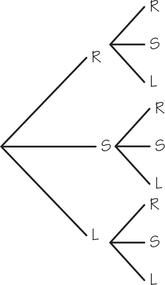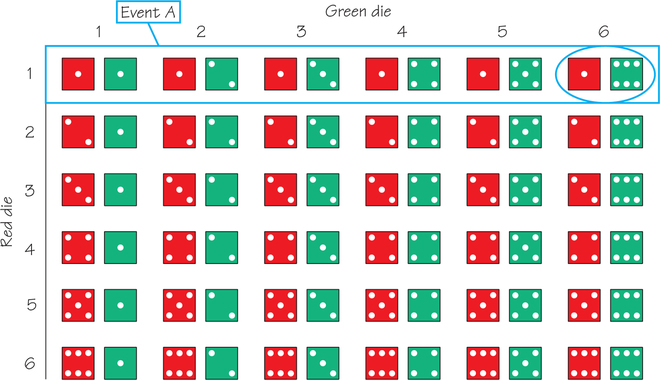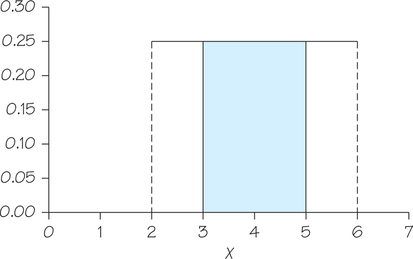Self Check Answers
![]() Self Check Answers
Self Check Answers

S={RR, RS, RL, SR ,SS, SL, LR, LS, LL}
- Following the diagonal directly above the longest rising diagonal shows five possibilities for a sum of 6. The probability is 5/36.
- Let A= worker uses public transportation and B= worker walks. P(A or B)=P(A)+P(B)=0.050+0.028=0.078.
- Let A= worker drives to work; P(Ac)=1−P(A)=1−0.860=0.140.
P(B)=16 . Next, we find P(A|B). Event A, shown in the blue rectangle, has six outcomes, each of which is equally likely. Given A has occurred, there is only one way to get a sum of 7(red=1 and green=6). P(B|A)=16=P(B). Therefore, A and B are independent.

Outcome Positive test Negative test Conditional probability given no arsenic 1−0.86=0.14 0.86 P(A and +)=(0.5)(0.97)=0.485
P(+)=P(A and +)+P(Ac and +)=0.485+(0.5)(0.14)=0.555P(A|+)=P(A and +)P(+)=0.4850.555≈0.874
Page 387Should be worried; the chance that arsenic is in the water, given the test was positive, is high.
- P(rolls doubles within first three tries) =16+562+5263≈0.42
Number of
rolls until
sum 71 2 3 4 5 … n … Probability 512 7⋅5122 72⋅5123 73⋅5124 74⋅5125 … 7n−1⋅512n … - This rule makes it less likely that players will spend a long time in jail. P(getting out of jail within first three rolls) =13851728≈0.80, which is nearly twice the probability under the Donovans’ old rules.
Using the table, the first digits on the invoice numbers are:
6, 8, 4, 1, 7, 3, 5, 1, 3, 1, 5, 5, 2, 9, 7, 2, 7, 6, 5, 8
The proportion of numbers assigned a first digit of 1, 2, or 3 is 0.35.
- The probability of observing a 1, 2, or 3, according to Benford’s law is 0.602. That is quite a bit higher than the answer to part (a); hence our fraud is likely to be detected.
- There are (27)(26)(25)(24)(23) = (421,200)(23) = 9, 687, 600 possible five-song playlists.
Let A be the playlists that include “The Ballad of John and Yoko.” This song could be the first, second, third, fourth, or fifth song on a playlist. If it is the first song, then there are 26 × 25 × 24 × 23 = 358, 800 ways to complete the playlist by choosing four songs in order from the remaining 26 songs. The same is true if “The Ballad of John and Yoko” is the second, third, fourth, or fifth song. Therefore, the number of outcomes in A is 5 × 358, 800 = 1,794,000 and
P(A)=1,794,0009,687,600≈0.185
- 6!=6×5×4×3×2×1=720
- Combination: 15C3=15!3!(15−3)!=(15)(14)(13)(3)(2)=455
- Permutation: 15P3=15!(15−3)!=(15)(14)(13)=2730
- 30P7=10,260,432,000; 7!=5,040; 30C7=2,035,800
The graph of the density curve (a) along with shaded region corresponding to part (b) appears below.

- P(3≤X≤5)=(5−3)(0.25)=0.5
Using products from the table below:
μ−0+0.26+0.30+0.21+0.12=0.89
Number who
call in sick, x0 1 2 3 4 Probability, p 0.49 0.26 0.15 0.07 0.03 Product, x⋅p 0 0.26 0.30 0.21 0.12 - P(win)=12/38≈0.3158; the gambler wins 31.58% of the time over many, many games. P(loss)=1−P(win)≈0.6842; the gambler loses 68.42% of the time over many, many games.
- (−1)(0.6842)+(2)(0.3158)=−0.0526; the house edge is exactly the same as for betting on red.
- σ=√(1−(−0.053))21838+(−1−(0.053))22038=√(1.053)21838+(−0947)22038=√0.9972≈$0.9986